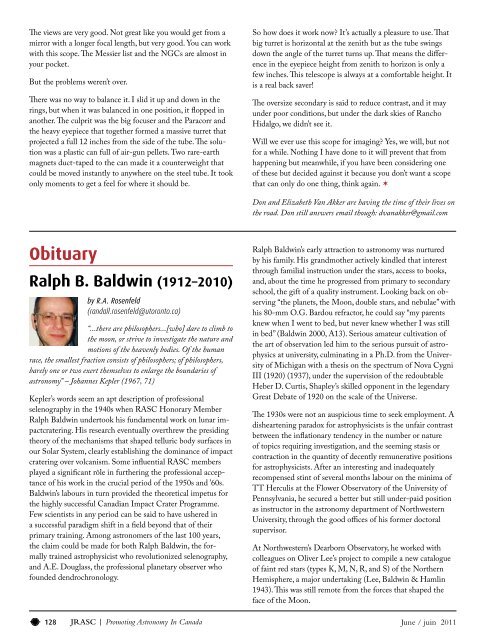The Running Man Nebula
The Running Man Nebula - The Royal Astronomical Society of ...
The Running Man Nebula - The Royal Astronomical Society of ...
You also want an ePaper? Increase the reach of your titles
YUMPU automatically turns print PDFs into web optimized ePapers that Google loves.
<strong>The</strong> views are very good. Not great like you would get from amirror with a longer focal length, but very good. You can workwith this scope. <strong>The</strong> Messier list and the NGCs are almost inyour pocket.But the problems weren’t over.<strong>The</strong>re was no way to balance it. I slid it up and down in therings, but when it was balanced in one position, it flopped inanother. <strong>The</strong> culprit was the big focuser and the Paracorr andthe heavy eyepiece that together formed a massive turret thatprojected a full 12 inches from the side of the tube. <strong>The</strong> solutionwas a plastic can full of air-gun pellets. Two rare-earthmagnets duct-taped to the can made it a counterweight thatcould be moved instantly to anywhere on the steel tube. It tookonly moments to get a feel for where it should be.So how does it work now? It’s actually a pleasure to use. Thatbig turret is horizontal at the zenith but as the tube swingsdown the angle of the turret turns up. That means the differencein the eyepiece height from zenith to horizon is only afew inches. This telescope is always at a comfortable height. Itis a real back saver!<strong>The</strong> oversize secondary is said to reduce contrast, and it mayunder poor conditions, but under the dark skies of RanchoHidalgo, we didn’t see it.Will we ever use this scope for imaging? Yes, we will, but notfor a while. Nothing I have done to it will prevent that fromhappening but meanwhile, if you have been considering oneof these but decided against it because you don’t want a scopethat can only do one thing, think again. VDon and Elizabeth Van Akker are having the time of their lives onthe road. Don still answers email though: dvanakker@gmail.comObituaryRalph B. Baldwin (1912–2010)by R.A. Rosenfeld(randall.rosenfeld@utoronto.ca)“...there are philosophers...[who] dare to climb tothe moon, or strive to investigate the nature andmotions of the heavenly bodies. Of the humanrace, the smallest fraction consists of philosophers; of philosophers,barely one or two exert themselves to enlarge the boundaries ofastronomy” – Johannes Kepler (1967, 71)Kepler’s words seem an apt description of professionalselenography in the 1940s when RASC Honorary MemberRalph Baldwin undertook his fundamental work on lunar impactcratering.His research eventually overthrew the presidingtheory of the mechanisms that shaped telluric body surfaces inour Solar System, clearly establishing the dominance of impactcratering over volcanism. Some influential RASC membersplayed a significant rôle in furthering the professional acceptanceof his work in the crucial period of the 1950s and ’60s.Baldwin’s labours in turn provided the theoretical impetus forthe highly successful Canadian Impact Crater Programme.Few scientists in any period can be said to have ushered ina successful paradigm shift in a field beyond that of theirprimary training. Among astronomers of the last 100 years,the claim could be made for both Ralph Baldwin, the formallytrained astrophysicist who revolutionized selenography,and A.E. Douglass, the professional planetary observer whofounded dendrochronology.Ralph Baldwin’s early attraction to astronomy was nurturedby his family. His grandmother actively kindled that interestthrough familial instruction under the stars, access to books,and, about the time he progressed from primary to secondaryschool, the gift of a quality instrument. Looking back on observing“the planets, the Moon, double stars, and nebulae” withhis 80-mm O.G. Bardou refractor, he could say “my parentsknew when I went to bed, but never knew whether I was stillin bed” (Baldwin 2000, A13). Serious amateur cultivation ofthe art of observation led him to the serious pursuit of astrophysicsat university, culminating in a Ph.D. from the Universityof Michigan with a thesis on the spectrum of Nova CygniIII (1920) (1937), under the supervision of the redoubtableHeber D. Curtis, Shapley’s skilled opponent in the legendaryGreat Debate of 1920 on the scale of the Universe.<strong>The</strong> 1930s were not an auspicious time to seek employment. Adisheartening paradox for astrophysicists is the unfair contrastbetween the inflationary tendency in the number or natureof topics requiring investigation, and the seeming stasis orcontraction in the quantity of decently remunerative positionsfor astrophysicists. After an interesting and inadequatelyrecompensed stint of several months labour on the minima ofTT Herculis at the Flower Observatory of the University ofPennsylvania, he secured a better but still under-paid positionas instructor in the astronomy department of NorthwesternUniversity, through the good offices of his former doctoralsupervisor.At Northwestern’s Dearborn Observatory, he worked withcolleagues on Oliver Lee’s project to compile a new catalogueof faint red stars (types K, M, N, R, and S) of the NorthernHemisphere, a major undertaking (Lee, Baldwin & Hamlin1943). This was still remote from the forces that shaped theface of the Moon.128 JRASC | Promoting Astronomy In Canada June / juin 2011
















